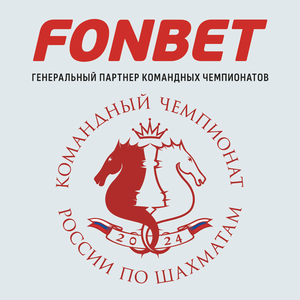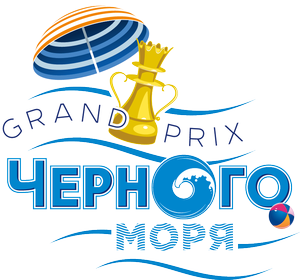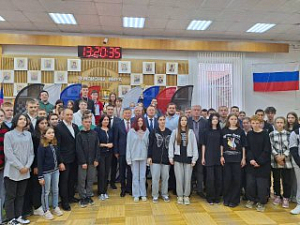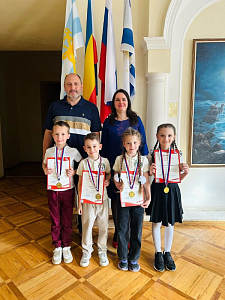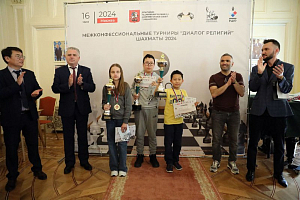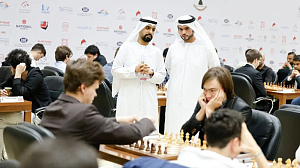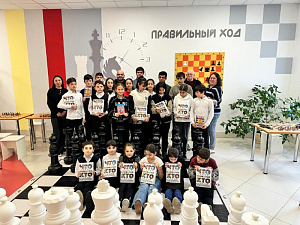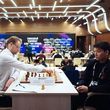Drama at the Finish
Rounds 7–9 of the Asian Cities Team Championship reviewed by IM Vladimir Barsky
Every sporting competition has some sort of intrigue – and that’s why we love sport. Of course, sometimes it happens that the recognized favourites easily go the full distance and win without as much as breaking a sweat. But the final result of the Khanty-Mansiysk competition only became known at the last hour. Surgut led, winning all their matches, but after losing the head-to head match Tehran gave a chase and caught up to them in individual points after round 7. In the penultimate round, both teams scored big wins, and everything was decided in the final round. The Iranians routed their opponents 4–0, while Surgut barely managed to save a difficult match against Pavlodar and won the first place. Tehran took the second place, Tula came third.
Congratulations to the winners and prizewinners, thanks to the organizers for an interesting tournament, and now let’s look at the fragments of interesting games from the last rounds.
Iljiushenok Ilia (Surgut, 2536) – Perchinsky Bogdan (Khanty-Mansiysk, 1807)
.jpg)
In this game, the formidable Surgut team faced the Khanty-Mansiysk junior team. Grandmaster Ilia Iljiushenok achieved a positional advantage (the brilliant knight is clearly stronger than the sad bishop on f8) and then placed a pretty trap for his opponent.
31.Qa8 Rxe4 32.Nxh6+
Deflection: 32...Rxh6 is now met with 33.Rxe4.
32...Kg7 33.Nxf7!
The knight is on a rampage!
.jpg)
33…Qf5
33...Kxf7 would have been met with 34.Rf3+ Rf6 35.Rxf6+, and this is, so to say, a double deflection: either the queen is distracted from defending the e4 rook, or the king from defending the f8 bishop.
34.Rxe4 Rxe4 35.Nxg5! (a final touch) 35…Re2 36.Nf3
The knight reaped a good pawn harvest and then came back to defend its king in time. Black resigned.
And now let’s look at the position after 32.Nxh6+ more closely. Turns out that Black could go straight into the trap: 32...Rxh6 33.Rxe4 (33.Qxe4 is met in the same way)
.jpg)
33...Qh8! Suddenly threatening a checkmate on h1. The only defence is 34.Kf1, but it’s met with 34…Qb2!, renewing the threat. After 35.Kg1 Qh8, the game ends in a repetition draw!
Turns out that the tactical blow 32.Nxh6 was not too good. White could include the trade 32.Rxe4 Qxe4 and only then play 33.Nxh6+, but after 33…Kg7 34.Qxe4 Rxe4 35.Nf5+ Kg6 36.Nxd6 Re7, Black, despite being a pawn down, has good chances for a draw: he will put his bishop onto the long diagonal and threaten the a3 and b4 pawns.
Did White really have an advantage in the position on diagram 1? Of course he did, but it seems that he should have gone for an endgame: 31.Qxe5 Rxe5 (not 31...dxe5? 32.Rd8 f6 33.Nxh6+) 32.Nxd6 Bxd6 33.Rxd6. White wins a pawn, even though Black can still resist well after 33…g4! (threatening 34…Rc1+ 35.Kh2 Rh5#). For instance: 34.f3 Rc1+ 35.Kf2 Re6 36.Rdd3 or 34.Rxh6 Kg7 35.Rh4 Rexe4 36.Rxe4 Rxe4 37.f3 Re3 38.Rxg4+ Kf6.
Palamar Stefan (Khanty-Mansiysk, 1813) – Bocharov Ivan (Surgut, 2559)
Another game from the same important 7th round match. In a very sharp line of Najdorf Sicilian White seemed to try to test his experienced opponent: if he remembers all the variations, there’s a draw, and if he forgets something, he loses by force. However, Stefan himself mixed things up in the crucial moment.
1.e4 c5 2.Nf3 d6 3.d4 cxd4 4.Nxd4 Nf6 5.Nc3 a6 6.Bg5 e6 7.f4 Be7 8.Qf3 Qc7 9.0-0-0 Nbd7 10.g4 b5 11.Bxf6 Nxf6 12.g5 Nd7 13.f5 0-0 14.Qh5 b4
.jpg)
15.Rd3
It’s too late to go back now: after 15.Nce2 e5 16.Nf3 Bb7, Black has a serious initiative.
15...bxc3 16.Rxc3
16.Rh3 Bxg5+! 17.Qxg5 cxb2+ 18.Kb1 Qd8 is better for White.
16...Qb6 17.Nc6 Bf6! 18.e5 g6 19.Qh6??
The wrong way! Black correctly answered all the “test questions”, and after 19.Qh4! Bxe5 20.Ne7+ Kh8 21.fxg6 fxg6 22.Nxg6+ Kg8 (22...Kg7 23.Qh6+ Kg8 24.Ne7+) 23.Ne7+ Kh8 (23...Kf7? 24.Qxh7+ Ke8 25.Nxc8) 24.Ng6+ Kg8, the game should have ended in a perpetual check.
.jpg)
19...Qf2!
A powerful Zwischenzug: Black threatens a mate on e1, and Bocharov’s queen returns in time to defend his king. After 19...Bg7??, however, White delivered a beautiful checkmate: 20.Ne7+ Kh8 21.Qxh7+! Kxh7 22.Rh3+ Bh6 23.Rxh6+ Kg7 24.f6+ Nxf6 25.exf6#.
20.Kd1 Bg7 21.Ne7+ Kh8
White resigned: after 22.Qxh7+ Kxh7 23.Rh3+ Bh6 24.Rxh6+ Kg7 25.f6+ Nxf6 26.exf6+ Qxf6! (спасибо промежуточному ходу!) 27.gxf6+ Kxh6, he is an exchange down in a completely broken position.
Pridorozhni Aleksei (Surgut, 2509) – Sattarov Dinis (Khanty-Mansiysk, 1760)
The youth could upset the experience in this game, but showed unexpected mercy.
.jpg)
Aleksei Pridorozhni slowly increased the pressure, and it seemed a good time for a final breakthrough. You can’t envy Black after 45.h5 gxh5 46.Rxh5 Rxg1 47.Kxg1 Rg8+ 48.Kf1 Bf8 49.Nc6. But the grandmaster decided to wait a bit more.
45.Rhg3 Qe7
We’ll note in parentheses that the h4 pawn is not hanging: 46…Qxh4+? is met with 47.Rh3, and the h6 bishop is lost.
46.Bxd5??
In the worst moment possible! White’s better position immediately becomes lost.
46…Nxf4! 47.Bg2
And now it turns out that the h4 pawn is hanging after all: 47.Bxf4 Qxh4+ 48.Rh3 Bxf4+, crushing.
47...Bxg2 48.R1xg2 Qxh4+ 49.Kg1 Nxg2 50.Rxg2 Bxe3+ 51.Qxe3 f4 52.Qd2 f3 53.Rf2
White is an exchange and a pawn down, his king is completely exposed… The only hope is that his young opponent, who’s not yet used to defeating grandmasters, would get nervous.
53…Qg3+
The shortest way to win: 53...Rgd8 54.Nc6 (54.d5 Rc4) 54...Rxc6 55.bxc6 Rxd4 56.c7 Rxd2 57.c8Q+ Rd8 58.Qc2 Qg3+ etc.
54.Kf1 Qh3+ 55.Kg1 Qg3+ 56.Kf1 Qh3+ 57.Kg1 Qg4+ 58.Kf1 Rgf8 59.Nc6 Rf4 60.Qd3 Rcf8 61.Ke1 Re4+ 62.Kd2 Rff4 63.Kc3 Re2 64.Rf1 Qg2 65.Qd1 Re3+ 66.Kc4 Qa2+ 67.Kb4
.jpg)
67...Qb2+
And here, Black missed a pretty mate in two: 67...Qa3+ 68.Kc4 Qc5#!
Afterwards, the grandmaster tried to make his opponent’s task as difficult as possible. Don’t forget that they were both already playing on increment.
68.Kc4 Qa2+ 69.Kb4 Qb2+ 70.Kc4 Qe2+ 71.Qxe2 fxe2 72.Rxf4 e1Q 73.Kd5 Qh1+ 74.Kd6 Rf3 75.Rg4 Qh3 76.Rg1 Rf1 77.Rxf1 Qxf1 78.e6 Kg7 79.d5 Qf5 80.Nxa7 Kf8 81.Nc6 Ke8 82.Kc7 Qxd5 83.Kxb6 Qxe6 84.a5 Qc8 85.a6 h5 86.a7 h4 87.Nb8 Qe6+ 88.Nc6 Qc8 89.Nb8 Qe6+ 90.Nc6 Qa2 91.Na5 Qf2+ Draw agreed. The computer shows that Black’s position is still won, but it’s computer… After so much excitement, it’s hard to keep your cool and calculate lines clearly.
Tuvshintulga Tumurchudur (Sukhabaatr, 1743) – Iljiushenok Ilia (Surgut, 2536)
1.d4 d5 2.Bf4 c5 3.e3 Nc6 4.c3 Qb6 5.Qb3 c4 6.Qc2
After 6.Qxb6 axb6 7.Nf3 Bf5, Black equalizes.
.jpg)
This opening tabiya occurred two times in the central match of the 8th round.
6...e5!?
A tough move, attempting to seize the initiative. We should point out that the immediate 6...Bf5 is bad due to 7.Qxf5! Qxb2 8.Qxd5 Qxa1 9.Qb5 0-0-0 (9...a6 10.Qxb7 is no better) 10.Bxc4. Therefore, Black first sacrifices a pawn to close off the fifth rank.
7.dxe5 Bf5 8.Qc1
And now White cannot capture the bishop, for instance: 8.Qxf5 Qxb2 9.e6 fxe6 10.Qxe6+ Be7 11.Qxd5 Rd8 12.Qxc4 Qc1+ 13.Ke2 Qd1#.
8...g5 9.Bg3
An alternative was 9.Bxg5 Nxe5 10.Nd2 f6 (10...Nd3+?! 11.Bxd3 Bxd3 12.Ne2) 11.Bf4 Ne7 with mutual chances.
9...h5 10.h3 Bg7 11.Nf3 0-0-0 12.Nxg5 Bxe5! 13.f4
A suspect move, but what else can we recommend for White? After 13.Nxf7 Bxg3 14.fxg3 Nf6 15.Nxd8 Rxd8 16.Be2 Ne4, Black’s initiative is quite dangerous.
It seems that the strongest move is 13.Bxe5 Nxe5 14.Nd2 Nf6 (Black can force a perpetual check here if he feels like it: 14...Nd3+ 15.Bxd3 Bxd3 16.Nxf7 Re8 17.Nxh8 Rxe3+! 18.Kd1 Be2+ 19.Kc2 Bd3+) 15.Ndf3 Nfd7 with double-edged play.
13...Bd6 14.Nxf7 Bc5
Despite material gains, White’s position becomes more and more dangerous with every move…
15.Bf2 Nf6 16.Nxd8 Rxd8 17.Be2 Re8 18.Qd2
18.Rf1 Bxe3 19.Bxe3 Rxe3 20.Rf3 Re6 is also joyless.
18...Bxe3 19.Bxe3 Rxe3 20.Kd1
.jpg)
20...Bd3!
After this stab, White is defenceless.
21.Re1 Bxe2+ 22.Kc1 Ne4 23.Qxd5 Nf2 24.Qf5+ Kc7 25.Kd2 Re7 26.Na3 Qe3+ 27.Kc2 Bd3+ White resigned.
Chuluunbaatar Gerelmaa (Sukhabaatr, 1731) – Pridorozhni Aleksei (Surgut, 2509)
1.d4 d5 2.Bf4 c5 3.e3 Nc6 4.c3 Qb6 5.Qb3 c4 6.Qc2 e5 7.dxe5 Bf5 8.Qc1 g5 9.Bg3 Bg7
Iljiushenok, as we remember, chose 9...h5.
10.Nf3 h5 11.Nxg5 h4 12.Bf4 Nxe5 13.Bxe5 Bxe5 14.Nd2 Nf6
Black’s initiative compensates (or almost compensates) the lack of pawn. White should play very carefully: any inaccuracy can spell doom.
.jpg)
15.Ndf3 Bc7 16.Be2 Ne4 17.Nd4 Qg6 18.Nxe4 Bxe4 19.Bf3 0-0-0 20.Qd2 h3 21.g3 Bxf3 22.Nxf3 Qe4 23.Qe2 d4!?
Black is inventive in his attempts to maintain the tension.
24.exd4 Qd5
.jpg)
25.0-0-0?!
The Mongolian chess player didn’t risk castling short, because it seems that he might get mated there in short order! However, analysis shows that it’s not that simple: 25.0-0 Rde8 26.Qd1 f5 27.b3 f4 28.Re1 fxg3 29.fxg3 Rxe1+ 30.Nxe1 Re8 31.Qg4+ Kb8 32.Qxh3, and White repels all the immediate threats and still has winning chances.
25...Rhe8 26.Ne5 f6 27.Qg4+ Kb8 28.f4 fxe5 29.fxe5
Three pawns for a knight – the material is roughly equal.
29…Rh8 30.Rhg1 Rdf8 31.Qe2 b5 32.Rdf1 Bd8 33.Kc2 Bg5 34.b3 Rc8 35.Qf3?
A blunder. The stronger move was 35.b4, closing off the position.
.jpg)
35...cxb3+ 36.axb3 Qxd4! 37.Rd1 Qe3
Stronger was 37...Rhf8! with an overwhelming advantage.
After the game move, Aleksei needed 60 more moves to break down the opponent’s resistance.
Kabanov Nikolai (Surgut, 2434) – Tsolmon Battur (Sukhabaatr, 1581)
The c-file breakthrough quickly decided the game in White’s favour.
.jpg)
18.c4 f5
More resilient was 18...dxc4 19.Bxc4 Nb6 20.Bb3 Nd5; however, even here White’s chances are better after 21.Kg2.
19.c5 Bc7
Joyless is 19...Be7 20.c6 bxc6 21.Rxc6 Kf7 22.Qe2, targeting the e6 pawn. Objectively, retreating to b8 with the bishop was better, but such a move is too counterintuitive…
20.c6 bxc6 21.Rxc6 Ke7
.jpg)
22.b4!
Another example of the deflection theme.
22…Qa3 23.Bc1 Qxa2 24.Rxc7, and White converted the extra piece.
Sattarov Dinis (Khanty-Mansiysk, 1760) – Mosadeghpour Masoud (Tehran, 2436)
.jpg)
24.c4?
Seemingly a blunder. After 24.Qe4 Qxc5+ 25.Nf2 Qe7 26.c4, the position remained roughly equal.
24...Nc3!
A brilliant discovered attack! The “dual” 24...Ne3? actually didn’t work because of 25.Nf6+ Kh6 26.Qxd8! Nxd8 27.Ng8+, and White wins.
25.Qxc3
25.Qxd8 is met with 25…Qxc5+ 26.Kf1 Nxd8 27.Rxd8 Qxc4+.
25...Rxd1+ 26.Kf2 Nd4 27.Ne3 bxc5!
Black managed to close off the long diagonal with tactical tricks.
.jpg)
28.h3
28.Nxd1 Qe2+ 29.Kg1 Qxd1+ 30.Kf2 Qe2+ 31.Kg1 h3 loses.
28...Rb1 29.Qd2 Qg5 30.Bxd4 cxd4 31.Qxd4 Qg3+ 32.Ke2 Qe1+ 33.Kd3 Rb3+ 34.Ke4 f5+ 35.Kd5 Qxe3 36.Qxe3 Rxe3 White resigned.
Bayantas Asman (Pavlodar, 2127) – Bocharov Ivan (Surgut, 2559)
We’ll finish with fragments of two games of the last round, where permanent leaders almost faltered. However, they managed to save the difficult match and keep their top place.
.jpg)
21...f6?!
Black equalized in the opening, but now he played too rashly. After the careful 21...Nd7 22.Bb2 Re8 23.Qf4 Nf8, he should not have too many problems.
22.e6 Bc4 23.Bb2 Re8 24.e7! Bxe7
This seems to be the decisive mistake. After 24...Qd7 25.Bh3 Qd5 26.Rac1, White exerts an unpleasant pressure, but there’s still a lot of struggle ahead.
25.Qxd4!
The endgame is very difficult for Black: the bishop is pinned, the knight can’t enter the play at all…
25…Qxd4 26.Bxd4 Rd7 27.Bxb6 Kf7 28.Rxe7+ Rexe7 29.Nxe7 Rxe7 30.Bxa5
.jpg)
White has a passed pawn and a bishop pair. Even though I. Bocharov resisted fiercely, he couldn’t save the game.
Pridorozhni Aleksei (Surgut, 2509) – Tkachyov Adil (Pavlodar, 2073)
The grandmaster outwitted his opponent: he lured Black’s pieces to queenside, and then suddenly opened a “second front” on the kingside.
.jpg)
26.f6!
In the style of Tal, who once, when asked why he sacrificed a pawn, answered, “It simply hindered me!”
26…Bxf6 27.Qf5
Here, however, the question of “why the sacrifice” is unnecessary: White wins two pawns in exchange for one of his.
27…Kg7 28.Qxh5 Rh8 29.Qxg4+ Kf8 30.h5 Rg8 31.Qf3 Nc4
31...d5 32.h6 Rc6 was somewhat more resilient.
32.Rc2 Rc6
.jpg)
33.a3!
To add insult to injury, Black also loses a piece (either through a pin or a fork), so he resigned.
Two other games of the match were drawn (with huuuuuge adventures on board 4!), and the mighty Surgut team won the gold medal of the Asian Cities Team Championship.









